基础实验
抓包分析
step1:搭建拓扑并配置相应IP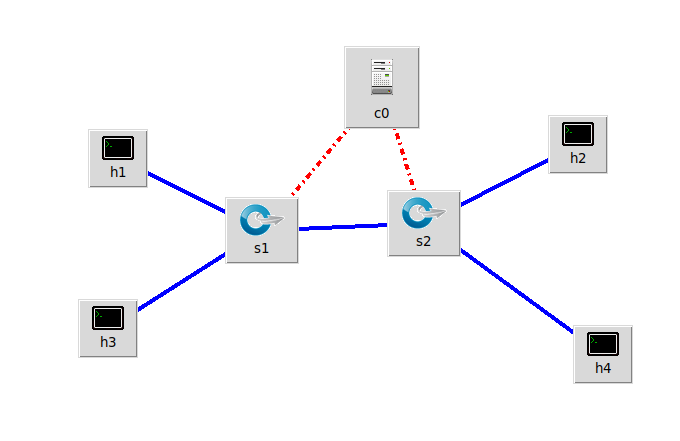
step2:
Pingall并抓包
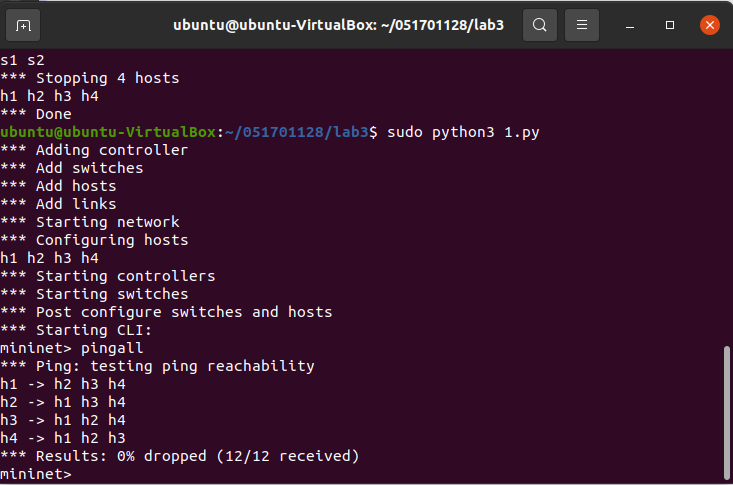
step3:分析
(1)hello包
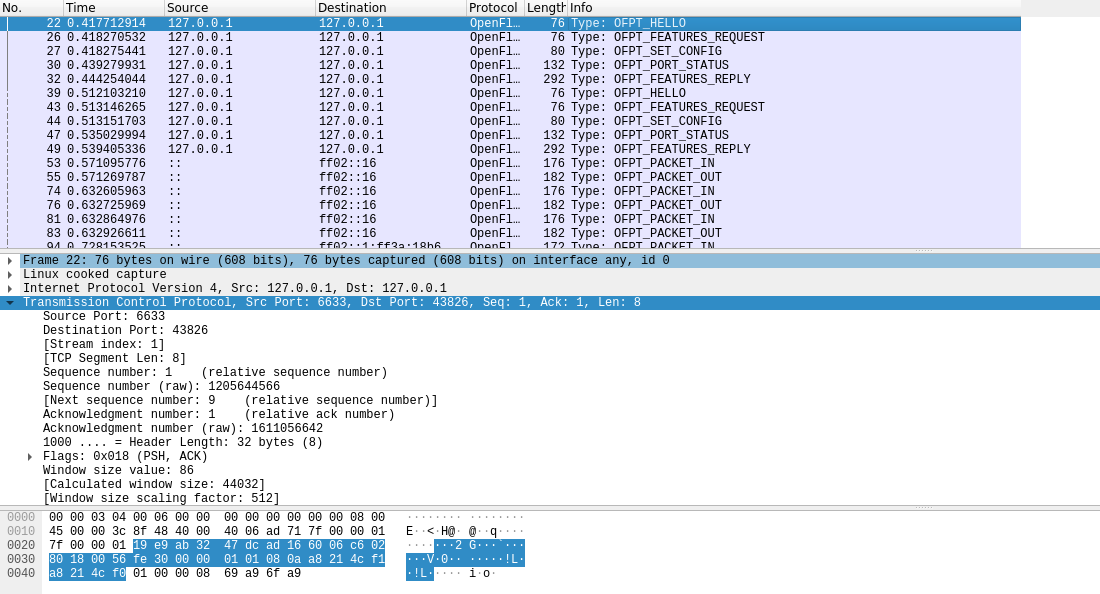
表示含义:控制器6633端口 发送“我最高能支持OpenFlow1.0”信息给交换机43826端口
于是双方建立连接,并使用OpenFlow1.0
(2)Feature_Request

表示含义:控制器6633端口发送“我需要你的特征信息”信息给交换机的43826端口
(3)Set_Config
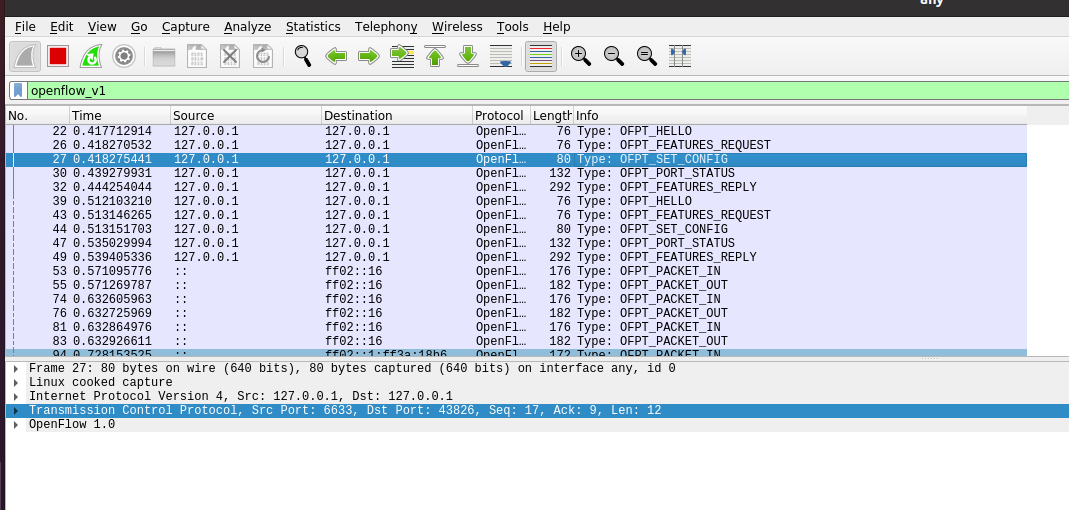
表示含义:控制器6633端口发送信息“请按照我给你的Flag和Max_Bytes of Packet进行配置"信息给交换机的43826端口
(4)Feature_Reply

表示含义:交换机43826端口发送“这是我的特征信息,请查收”信息给控制器的6633端口
(5)Packet_in
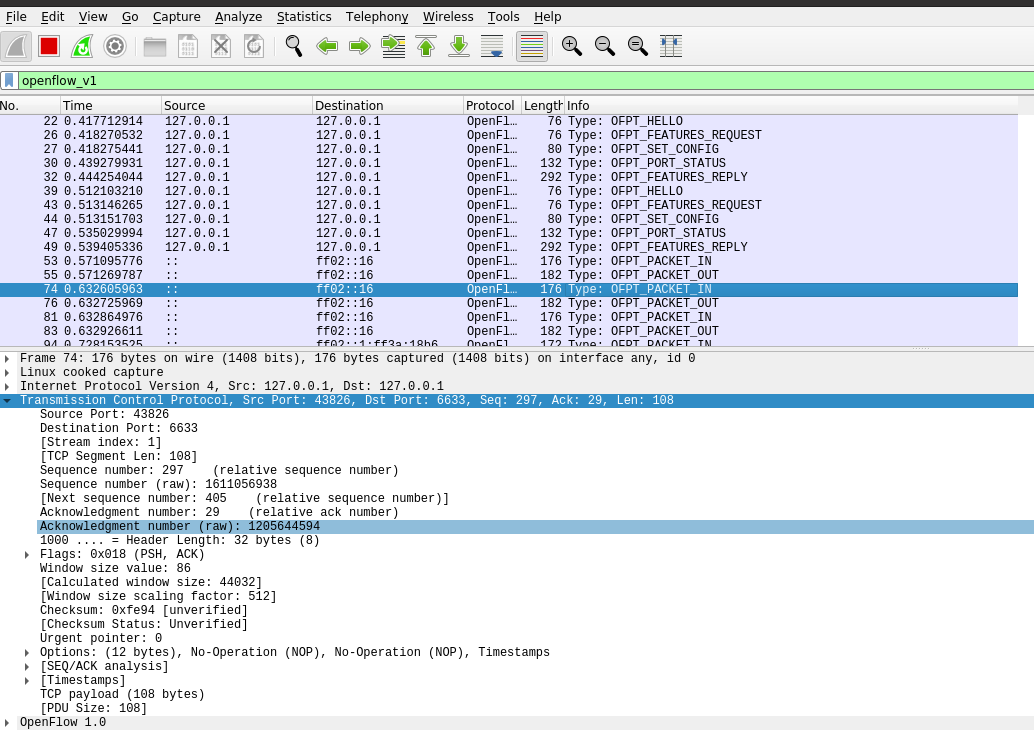
表示含义:交换机43826端口发送“有数据包进入,请指示”信息给控制器的6633端口
(6)Packet_out
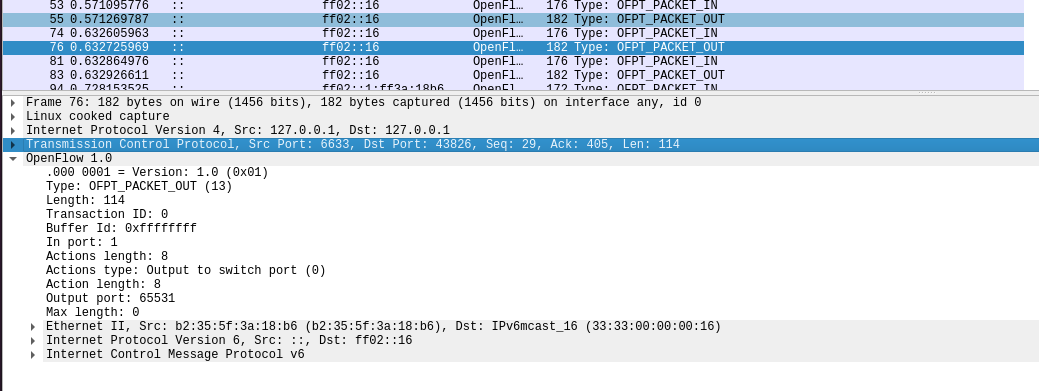
表示含义:控制器6633端口发送“请按照我给你的action进行处理”信息给交换机的43826端口
(7)Flow_Mod
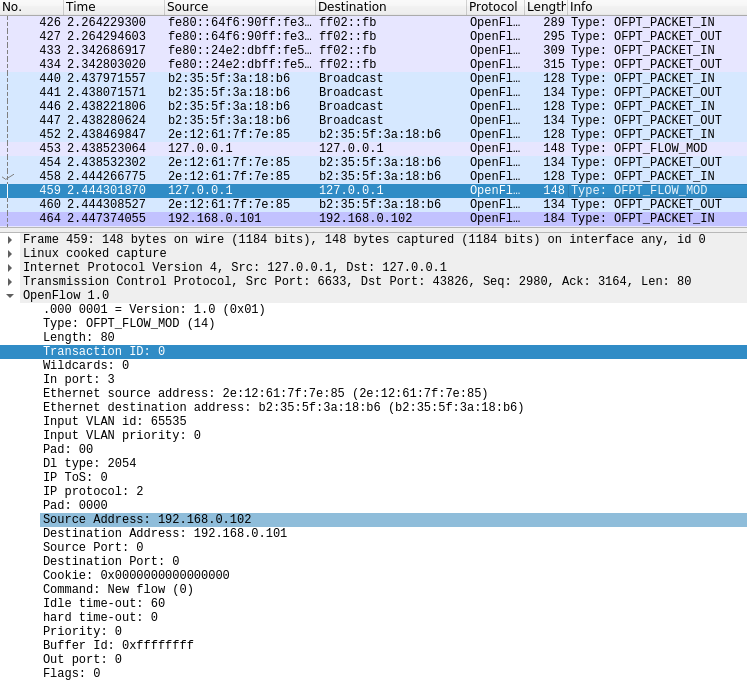
表示含义:控制器通过6633端口向交换机43836端口下发流表项,指导数据的转发处理。
(8)Port_status
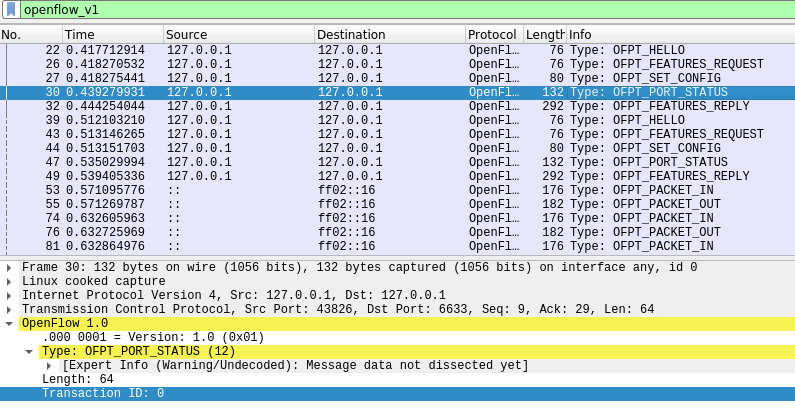
当交换机端口发生变化时,告知控制器相应的端口状态。
交互图
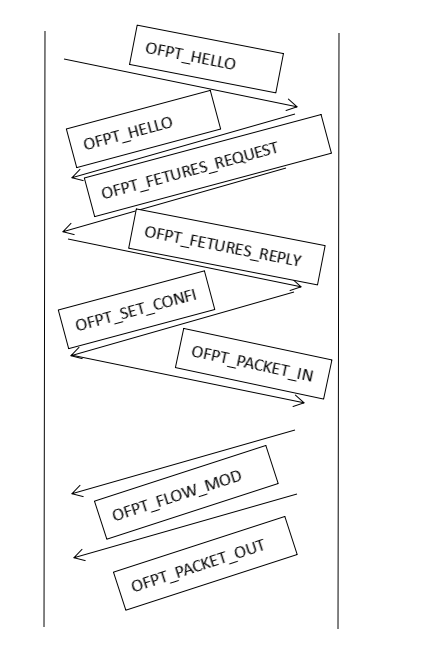
问题回答
交换机与控制器建立通信时是使用TCP协议还是UDP协议?
TCP协议
进阶要求
查看OpenFlow目录下的头文件
HELLO
OpenFlow的数据包头通用字段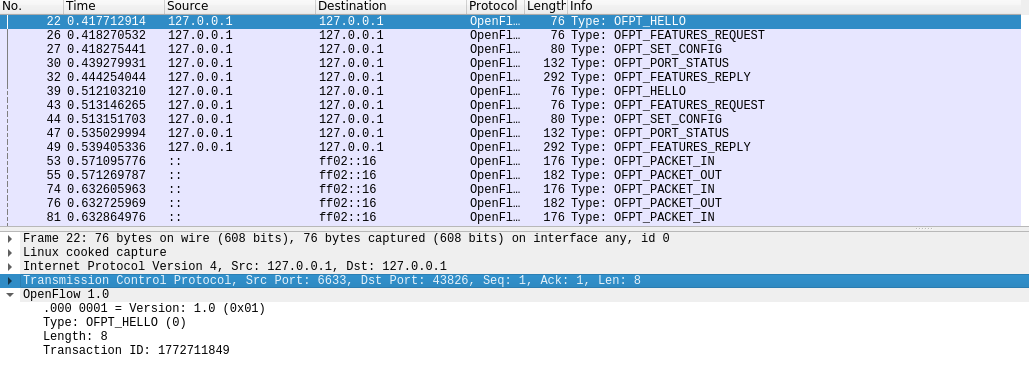
struct ofp_header {
uint8_t version; /* OFP_VERSION. */
uint8_t type; /* One of the OFPT_ constants. */
uint16_t length; /* Length including this ofp_header. */
uint32_t xid; /* Transaction id associated with this packet.
Replies use the same id as was in the request
to facilitate pairing. */
};
HELLO报文的四个参数
FEATURES_REQUEST

源码参数格式与HELLO相同,与上述ofp_header结构体中数据相同
SET_CONFIG
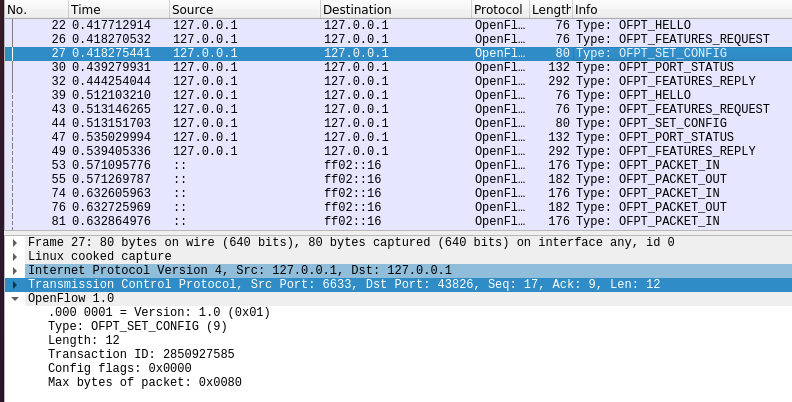
控制器下发的交换机配置数据结构体
/* Switch configuration. */ struct ofp_switch_config { struct ofp_header header; uint16_t flags; /* OFPC_* flags. */ uint16_t miss_send_len; /* Max bytes of new flow that datapath should send to the controller. */ };
PORT_STATUS

/* A physical port has changed in the datapath */ struct ofp_port_status { struct ofp_header header; uint8_t reason; /* One of OFPPR_*. */ uint8_t pad[7]; /* Align to 64-bits. */ struct ofp_phy_port desc; };
FEATURES_REPLY
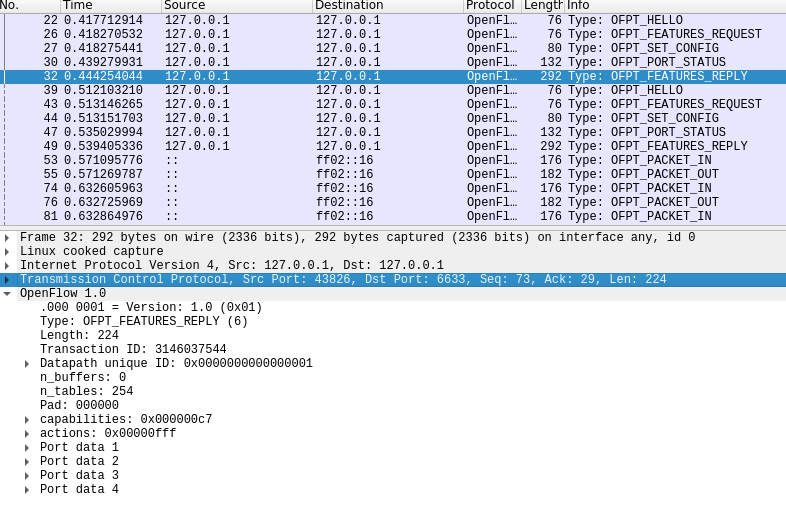
/* Switch features. */ struct ofp_switch_features { struct ofp_header header; uint64_t datapath_id; /* Datapath unique ID. The lower 48-bits are for a MAC address, while the upper 16-bits are implementer-defined. */ uint32_t n_buffers; /* Max packets buffered at once. */ uint8_t n_tables; /* Number of tables supported by datapath. */ uint8_t pad[3]; /* Align to 64-bits. */ /* Features. */ uint32_t capabilities; /* Bitmap of support "ofp_capabilities". */ uint32_t actions; /* Bitmap of supported "ofp_action_type"s. */ /* Port info.*/ struct ofp_phy_port ports[0]; /* Port definitions. The number of ports is inferred from the length field in the header. */ }; /* Description of a physical port */ struct ofp_phy_port { uint16_t port_no; uint8_t hw_addr[OFP_ETH_ALEN]; char name[OFP_MAX_PORT_NAME_LEN]; /* Null-terminated */ uint32_t config; /* Bitmap of OFPPC_* flags. */ uint32_t state; /* Bitmap of OFPPS_* flags. */ /* Bitmaps of OFPPF_* that describe features. All bits zeroed if * unsupported or unavailable. */ uint32_t curr; /* Current features. */ uint32_t advertised; /* Features being advertised by the port. */ uint32_t supported; /* Features supported by the port. */ uint32_t peer; /* Features advertised by peer. */ };
可以看到与图中信息一一对应,包括交换机物理端口的信息
PACKET_I
在控制器获取完交换机的特性之后 , 交换机开始处理数据。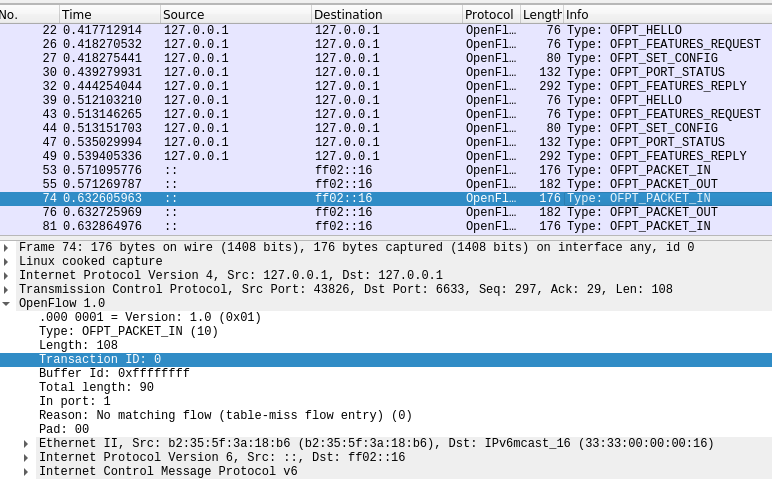
/* Packet received on port (datapath -> controller). */ struct ofp_packet_in { struct ofp_header header; uint32_t buffer_id; /* ID assigned by datapath. */ uint16_t total_len; /* Full length of frame. */ uint16_t in_port; /* Port on which frame was received. */ uint8_t reason; /* Reason packet is being sent (one of OFPR_*) */ uint8_t pad; uint8_t data[0]; /* Ethernet frame, halfway through 32-bit word, so the IP header is 32-bit aligned. The amount of data is inferred from the length field in the header. Because of padding, offsetof(struct ofp_packet_in, data) == sizeof(struct ofp_packet_in) - 2. */ };
OFPT_PACKET_OUT
控制器可以使用PacketOut消息,告诉交换机某一个数据包如何处理。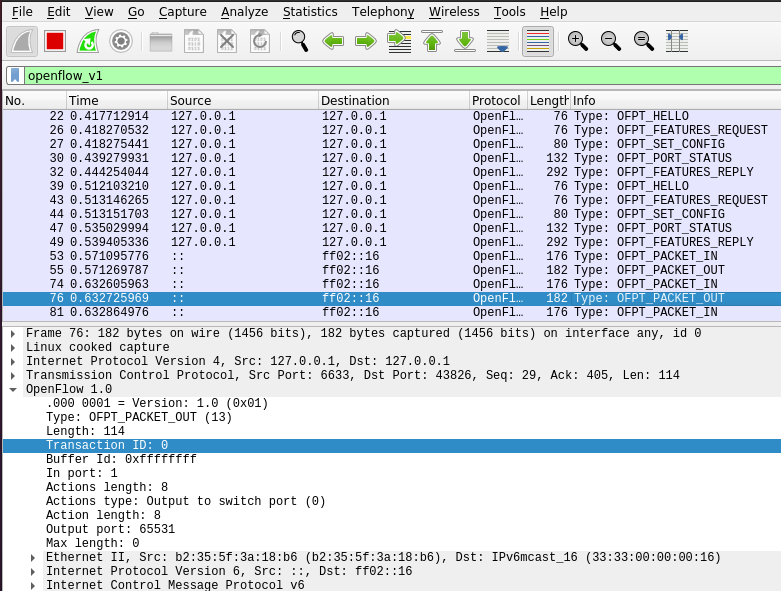
/* Send packet (controller -> datapath). */ struct ofp_packet_out { struct ofp_header header; uint32_t buffer_id; /* ID assigned by datapath (-1 if none). */ uint16_t in_port; /* Packet's input port (OFPP_NONE if none). */ uint16_t actions_len; /* Size of action array in bytes. */ struct ofp_action_header actions[0]; /* Actions. */ /* uint8_t data[0]; */ /* Packet data. The length is inferred from the length field in the header. (Only meaningful if buffer_id == -1.) */ };
FLOW_MOD
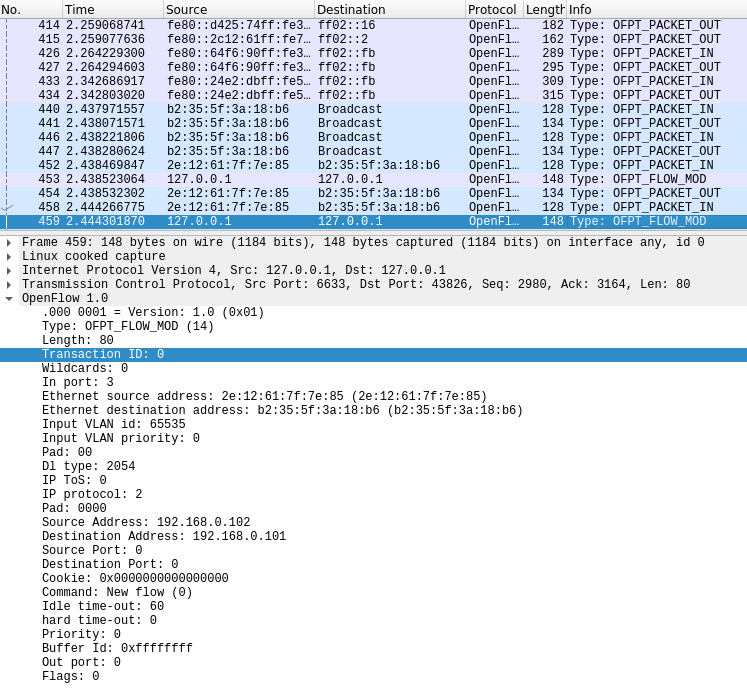
struct ofp_flow_mod { struct ofp_header header; struct ofp_match match; /* Fields to match */ uint64_t cookie; /* Opaque controller-issued identifier. */ /* Flow actions. */ uint16_t command; /* One of OFPFC_*. */ uint16_t idle_timeout; /* Idle time before discarding (seconds). */ uint16_t hard_timeout; /* Max time before discarding (seconds). */ uint16_t priority; /* Priority level of flow entry. */ uint32_t buffer_id; /* Buffered packet to apply to (or -1). Not meaningful for OFPFC_DELETE*. */ uint16_t out_port; /* For OFPFC_DELETE* commands, require matching entries to include this as an output port. A value of OFPP_NONE indicates no restriction. */ uint16_t flags; /* One of OFPFF_*. */ struct ofp_action_header actions[0]; /* The action length is inferred from the length field in the header. */ }; /* Action header that is common to all actions. The length includes the * header and any padding used to make the action 64-bit aligned. * NB: The length of an action *must* always be a multiple of eight. */ struct ofp_action_header { uint16_t type; /* One of OFPAT_*. */ uint16_t len; /* Length of action, including this header. This is the length of action, including any padding to make it 64-bit aligned. */ uint8_t pad[4]; };
(三)实验总结
本次实验使用wireshark进行抓包以及对抓包结果进行分析制作流程图
清除拓扑结构再运行sudo mininet/examples/miniedit.py 搭建拓扑,进行设置和配置,export文件。另起一个终端运行wireshark,再运行拓扑结构,pingall得到想要的结果。
在进行抓包时必须一次性完成所有包的查找分析,否则再次启动虚拟机时,会发生两次抓包同一个包而端口不一致的情况。
通过本次实验,我能够熟练地运用 wireshark 对 OpenFlow 协议数据交互过程进行抓包。认识到controller和switches通信是通过TCP协议,建立起可靠传输,里面包裹openflow协议。对 OpenFlow 协议的数据包交互过程与机制有了更深入的了解。通过和源码对照,能够直观的认识到不同类型的数据报的组成,以及各字段所代表的意义和作用。



